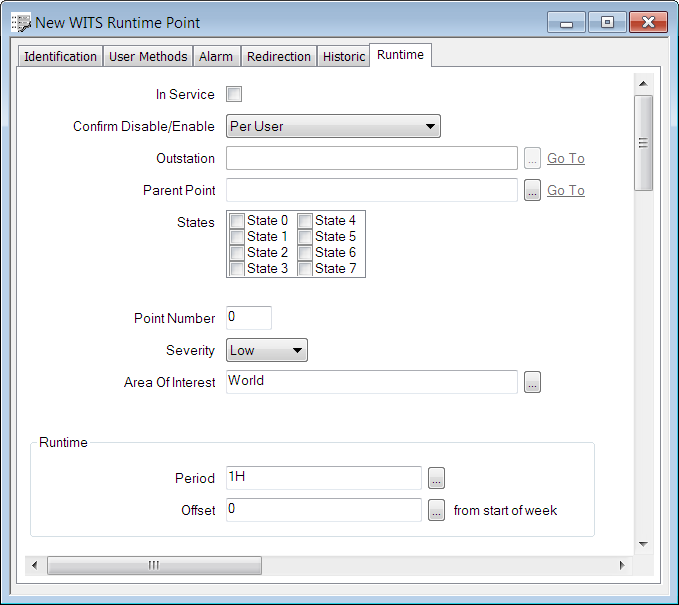In ClearSCADA, a WITS Runtime Point database item represents a Runtime point in a WITS Field Device. You use a Runtime point to measure the amount of time (that is, the runtime) that a particular point spends in a specific state or states. An example runtime might be the amount of time that a pump has run each day.
The Field Device measures the runtime over a specific period and stores the resulting value (in seconds) in the Runtime point. The stored value is the total runtime since the start of the current period. At the start of the next period, the Field Device resets the runtime to zero.
The Runtime point is a virtual counter point. It is also a derived point. That is, it derives its value by performing a calculation on the value of another point (the parent point) (see Derived Points in the ClearSCADA Guide to Core Point Configuration).
The Field Device might not update the Runtime point continuously. It might update the point:
- Periodically (for example, once per minute)
- When the parent point changes state
- When the parent point's quality flags change.
If the Field Device does not continuously update the Runtime point then any configured periodic logging and limit actions may not behave as expected.
WITS Runtime Point database items have a combination of configuration properties that are:
- Common to many types of point
- Common to DNP3 Points
- Common to WITS Points
- Common to WITS Counter Points
- Specific to WITS Runtime Points.
To configure a WITS Runtime Point database item, you use the WITS Runtime Point Form.

The Form contains many fields, organized into tabs. Some of these tabs are common to many types of database item (see Tabs on Point Forms in the ClearSCADA Guide to Advanced Drivers).
The Runtime tab contains properties that are specific to WITS. Use the fields on the tab to:
- Configure the point's General Properties (see General Point Properties - WITS Runtime Points)
- Specify the point (the parent point) for which the Field Device should calculate the runtime value (see Specify a Parent Point )
- Specify the states for which you want to calculate the runtime value (see Point States for WITS Runtime Points)
- Configure the point's Runtime Properties. You can specify the calculation period and enable runtime value logging (see Runtime Properties for WITS Runtime Points)
- Configure the point's Scanning State Properties (see Scanning States for WITS Database Points)
- Configure the point's Alarm Limits (see Alarm Limits for WITS Counter-Type Points)
- Configure any Alarm Limit Profiles (see Profiles for WITS Database Points)
- Configure the point's DNP3 Object Flag Options (see DNP3 Object Flag Actions)
- Configure the point's Formatting Properties (see Define the Appearance of a Counter-Type Point's Values in the ClearSCADA Guide to Core Point Configuration)
- Configure the point's Override Properties (see Define Whether a Counter-Type Point can be Overridden in the ClearSCADA Guide to Core Point Configuration)
- Configure the point's Trend Properties (see Define a Counter-Type Point's Trend Settings in the ClearSCADA Guide to Core Point Configuration)
- Configure the point's Logged Data Properties (see Logged Data for WITS Database Points)
- Configure the point's Historic Data Filter Properties (see Historic Data Filter for WITS Database Points).
When you have completed the point's configuration, you need to download the configuration to the Field Device by using the Outstation database item's Download Configuration (WITS Outstation) action.
If your Field Device does not support configuration download, you will need to make the same changes to the Field Device's configuration locally.